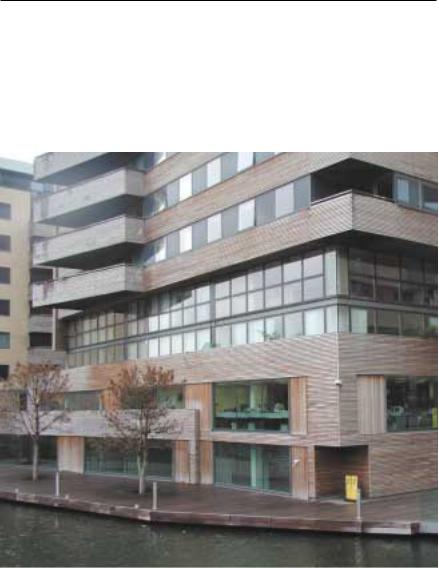
"Better Neighbourhoods - Making higher densities work" (CABE)
.pdf
Better Neighbourhoods: Making higher densities work

Foreword 3
Summary 4
1/ Challenges 5
2/ Benefits 11
3/ Barriers 16
4/ Key factors for success 18
5/ Recommendations 26
Appendix: Tools for better neighbourhoods

Foreword
Building new housing at higher densities is increasingly being seen
as the solution to the high demand for housing and the acute shortage of land in London and the south east of England.
Yet building at higher density is often viewed as a problem rather than an opportunity, and can present major challenges, particularly in terms
of achieving agreement between local authorities, developers and residents.
This report considers how barriers to successful higher-density housing can be overcome. It analyses the challenges associated with building at higher densities, and shows how housing intensification can provide significant benefits for developers and residents alike. It argues for an understanding of how higher densities can create popular, sustainable neighbourhoods.
The key to building successful communities is to achieve consensus among all those involved in the development process. Yet the range of potential barriers to building higher-density housing, the complexity of the process and the variety of interests involved can create adversarial situations, resulting in too many low-quality developments being built.
A significant idea emerging from this report is the use of a charter or compact to agree minimum standards between local authorities and developers.
This approach is already being trialled in various parts of the country.
So much guidance, research and policy information is already available on housing density that information overload can be a problem. This report provides a shortcut – it analyses key issues, and combines the most useful research in one document. It can help public and private sectors work together to realise the benefits of building better neighbourhoods and
to make higher density work.
Peter Derrick |
Richard Simmons |
Chamberlain, Corporation of London |
Chief Executive, CABE |
3

Summary
Introduction
This short report addresses how to increase the supply of homes in areas of high demand, and in particular how to build at higher densities without sacrificing quality.
It draws on new research into housing intensification commissioned by CABE and the Corporation of London. It also includes a literature review and stakeholder interviews assessing barriers to high density, as well as
five case studies.
Case studies include large strategic sites in a metropolitan city, small urban infill sites, intensification around transport nodes, edge-of-town growth/new out- of-town settlements, and the regeneration of local authority estates. The literature review and case studies are featured on CABE’s Building for Life website www.buildingforlife.org.
The report also draws on CABE’s Design Reviewed publications, considers projects reviewed by CABE’s expert design panel, and looks at CABE’s report on what house buyers want from their homes. All these are available at www.cabe.org.uk
The report is divided into five sections, which cover:
1/The challenge of higher densities 2/The benefits of higher densities 3/The barriers to higher densities 4/Key factors for success
5/Tools for better neighbourhoods.
The report aims to:
•Respond to changing national policies, pressures for innovation, the imbalance between supply and demand, and the need for new types of housing
•Provide a basis for negotiating a charter for better neighbourhoods, or for charters with individual developers where they agree to abide by agreed standards
The report can be used to:
•Provide a quick review of all relevant research to help councillors and others entering unfamiliar territory
•Offer tools to assess and reach agreement on major schemes
•Develop new ways of more collaborative working
Findings
The key recommendations of the report are for partners to:
•Adopt a more consensual approach throughout the development process, including the use of charters and development agreements
•Build capacity among local authorities and developers
•Investigate use of planning and development charges
•Share learning between all participants in the development process
The report emphasises the importance of consensus for successful development, and argues the case for using a charter to reach agreement between the public and private sectors on improving standards of design, sustainability, affordability and community benefits,
in areas of housing growth where higher densities are appropriate.
It stresses that the aim is to create better neighbourhoods, not just boost housing numbers. In situations where high density is appropriate – adjoining town centres and transport nodes or overlooking public space – it works well, provided public authorities and house builders are partners and not adversaries.
4

1/ Challenges
Definition of density used in PPG3
Net site density includes only those areas that will be developed for housing and directly associated uses, this includes: 1/access roads within the site
2/private garden space
3/car parking areas
4/ incidental open space and landscaping
5/children’s play areas It excludes:
1/major distributor roads
2/primary schools
3/open spaces serving a wider area
4/significant landscape buffer strips
Measurements of density
1/Dwellings or units per hectare or per acre (the number of homes on a site)
2/Habitable rooms (meaning rooms that people actually live in) per hectare or per acre (for example a two bedroom house with one double and one single bedroom, living room, kitchen and bathroom counts as having three habitable rooms, as kitchens and bathrooms are not included in the measurement)
3/People or bed spaces per hectare or per acre (using the above example the two bedroom house sleeps up to three people)
4/Plot ratios (the total area of the building
– the floor area multiplied by the number of storeys/the area of the site)
The aim of building at increased densities to make better use of constrained land supply is now enshrined in policy, for example through the Government’s Planning Policy Guidance Note 3 (PPG3). However, while there are many benefits to building at higher densities the subject remains controversial with developers, local authorities and the public. There
is concern among professionals at the extra expense that can sometimes be associated with building at high densities. For instance, the need to provide extra features, such as communal facilities, can increase costs in some developments, though these costs are often outweighed by added value. Equally, the complexity of obtaining permission for higher densities can have financial consequences for developers.
There is also public distrust of higher density housing schemes, often centred on the belief that too many residents will create overcrowding and associated problems. Pressure on parking space is a major concern, but the general perception is that more people living
in the same amount of space will inevitably reduce the quality of life for existing residents.
Despite these misgivings, housing will be built across London and the South
East at the densities demanded by PPG3. Higher-density developments can help to create more viable neighbourhoods capable of supporting local services. However, opposition will only be won over by high quality designs that can demonstrate that
the benefits of higher-density housing will offset the real and perceived disadvantages. Our common goal
is to create better neighbourhoods, and higher densities should be seen as the means rather than the end.
Furthermore, though each development site will be different, there are some techniques that can be used to streamline the process and secure
a range of benefits.
Although most people agree on
the need to provide more and better housing, in practice almost every major planning application will generate debate and public interest. Higherdensity housing causes particular concern because it is associated by many people with unpopular types of housing, but we often forget that it also
includes examples such as urban villages and historic market towns. The failure of some types of housing often has very little to do with their density and more to do with underlying social or management issues.
5

1/ Challenges
Despite all the stress on improved design, exemplary higher-density housing schemes are still disappointingly rare,
as found by CABE’s 2004 Housing Audit, based on an assessment of 100 recent schemes.
To better understand the barriers, CABE and the Corporation of London commissioned this report and background research which is featured on CABE’s Building for Life website www.buildingforlife.org.
In addition, the report draws on CABE’s Design Reviewed: urban housing, lessons learnt from projects reviewed by CABE’s expert design panel, and a report for CABE summarising the results of market research into what house buyers want from their homes.
Changing policy priorities
Both house building rates and investment levels lag far behind what is needed
to make up the current shortfall. For local authorities the main impetus for change comes from the reform of the planning system through the Planning and Compulsory Purchase Act 2004. Other policies, like PPG3 and its companion guide Better Places to Live, seek to encourage more sustainable development. The Office of the Deputy
Prime Minister’s Sustainable Communities Plan focuses on increasing house building in the Growth Areas and its objectives
are taken up in regional plans which set density guidelines according to the
character of areas and their accessibility by public transport. These could be evaluated against a density gradient
as illustrated by the table opposite.
‘Many local authorities would welcome a stalemate on the density issue which blocks development altogether.’ 1
The meaning of density
Older housing types |
Recent developments |
Alternative approaches |
Victorian Terraces |
|
Executive Homes |
|
Urban Villages |
60–80 dwellings/ha. |
|
5–10 dwellings/ha. |
|
75–125 dwellings/ha. |
280 (average) habitable rooms/ha. |
|
40 (average) habitable rooms/ha. |
|
500 (average) habitable rooms/ha. |
|
|
|
|
|
|
Garden Cities |
|
|
Suburban Semis |
|
|
Infill in Historic Towns |
|
|
|
|
|
|||
|
30–40 dwellings/ha. |
|
|
15–30 dwellings/ha. |
|
|
80–140 dwellings/ha. |
|
165 habitable rooms/ha. |
|
|
90 (average) habitable rooms/ha. |
|
|
500 (average) habitable rooms/ha. |
|
|
|
|
|
|
|
|
6

What is higher density development?
The following table shows that density itself should not be viewed as a reliable guide to the form or quality of residential development.
Density gradient |
Units/Ha |
Persons/Ha |
Low density detached – Hertfordshire |
5 |
20 |
Average net density – Los Angeles |
15 |
60 |
Milton Keynes average 1990 |
17 |
68 |
Average density of new development in UK 1981–91 |
22 |
88 |
Minimum density for a bus service |
25 |
100 |
Private sector 1060s/70s – Hertfordshire |
25 |
100 |
Inner-war estate – Hertfordshire |
30 |
120 |
Private sector 1980s/90s – Hertfordshire |
30 |
120 |
Hulme – Manchester 1970s |
37 |
148 |
Average net density London |
42 |
168 |
Ebenezer Howard – Garden city 1898 |
45 |
180 |
Minimum density for a tram service |
60 |
240 |
Abercrombie – low density |
62 |
247 |
New town higher density low-rise – Hertfordshire |
64 |
256 |
Sustainable urban density |
69 |
275 |
Victorian/Edwardian terraces – Hertfordshire |
80 |
320 |
Abercrombie – Medium density |
84 |
336 |
Central accessible urban density |
93 |
370 |
Holly Street – London 1990s |
94 |
376 |
Holly Street – London 1970s |
104 |
416 |
Abercrombie – High density |
124 |
494 |
Hulme – Manchester 1930s |
150 |
600 |
Average net density Islington – 1965 |
185 |
740 |
Singapore planned densities 1970s |
250 |
1,000 |
Kowloon actual |
1,250 |
5,000 |
An average dwelling size of 4 bedspaces has been assumed throughout this table although
it should be noted that this is higher that the average household size in the UK
7

1/ Challenges
The new planning system also puts extra emphasis on involving communities early on, and preparing design and access statements showing how new developments will fit into existing areas and meet policy objectives.
These initiatives combine to transform the planning process and provide a potential basis for a charter with specific partners to resolve conflicts over complex schemes.
The new system is intended to be more flexible, while also providing a stronger lead, and will affect house building in
a number of ways.
Pressures for innovation
A number of studies have called for radical changes to the way we plan and design housing. Economist Kate Barker’s 2004 Review of Housing Supply for the Treasury said that Britain had the highest house price inflation but the lowest building rates in Europe because of its adversarial system. It recommended paying more attention to ‘market signals’
– in other words, councils should understand more about the economics of development.
The ODPM’s 2003 Egan Review of Skills clearly put responsibility on councils to be more proactive in managing urban
change, said officers should have more authority, and reinforced the importance of improving design through skills development at national level. There are also pressures to modernise construction methods, and new policies to enable private house builders to provide social housing.
Imbalance between supply and demand
The Town and Country Planning Association claims the root cause of the housing problem lies in supply and demand: ‘Mainly as a result of too few homes for sale being built, prices have been forced up to unaffordable levels. It is not possible for many people
on average incomes to buy even cheaper homes.’
Rising housing demand looks unavoidable as people live longer, as family structures change and as
individuals demand more living space.
Projections for south east England show supply lagging far behind demand, while London’s position is aggravated by people from elsewhere moving in. And although private house builders have maintained output, social house building has dropped sharply, leading
to the lowest levels of public sector completions since the 1920s.
The new planning system and housing
•Housing development has to comply with a plan-led system that is not only intended to secure the best use of land, but also to achieve a range of other objectives. Spatial planning links land use issues to other service provisions and public interventions.
•There is a spatial hierarchy, with Regional Spatial Strategies and subregional Spatial Frameworks providing the context for Local Development Frameworks and Community Strategies, and Local Development Documents including Area Action Plans for specific areas that are at risk or that offer major development opportunities.
•The Local Development Frameworks will consist of a suite of documents, including a Statement of Community Involvement that will set out how to engage the community and how consultations are to be handled. This could include how the impact of new housing schemes is to be assessed.
•Design and Access Statements are required to accompany planning applications to justify and explain the approach
•Section 106 on Planning Obligations is being amended to allow for tariffs to be charged, and planning fees on major applications are also likely to be changed.
‘…other groups… are often dismissed as niche markets but in reality they outnumber the young families generally regarded as the mass-market. Three in every four households are childless and more than half of these are below retirement age.’2
8

‘Factors which were not necessarily related to density appeared to be the most important in their priorities, size of home, its design details, the quality of construction’ … ‘when choosing an area to live in, people were attracted by
low crime rates, good health facilities, low cost of living, good shopping and good race relations’ 3
1/ Challenges
Need for fresh approaches |
than a flat in an inner city area. Older |
|||
Future demands cannot be met by |
people say they would prefer a bungalow. |
|||
building detached houses. It may have |
However, probing behind the initial |
|
||
suited house builders to build detached |
responses, it is possible to see how |
|||
homes in the past, because they were |
many people’s requirements can be |
|||
relatively easy and profitable to develop |
met through building at higher densities. |
|||
on greenfield sites. But in the South East |
|
|
|
|
there has been a dramatic shift towards |
Modern apartments can offer better |
|||
building flats and maisonettes. |
security than many detached houses. |
|||
|
They can also provide affordable, usable |
|||
Matthew Carmona in Housing Design |
outside space, often in the form of shared |
|||
Quality (Spon Press 2005) points out |
gardens or a balcony. Most people want |
|||
that, ‘The product is the house and only |
to live in somewhere distinctive and |
|||
to a lesser extent the context it defines. |
with character, which can be provided |
|||
The simplest way to judge what sells |
if housing is well-designed. Everyone |
|||
is to repeat what sold before’. |
wants privacy, which is why sound |
|
||
|
insulation is important, and layout |
|
||
But as with most products, housing |
that is designed to avoid problems of |
|||
is going through a revolution. |
overlooking. Elderly or disabled people |
|||
|
can have the advantage of easy access, |
|||
New types of layout, fittings, and building |
if lifts are well-maintained. |
|
||
methods have joined new concepts |
|
|
|
|
like loft apartments and urban villages. |
As house buyers worry about their |
|
||
There is also a return to the kinds of |
investment, they are very concerned with |
|||
neighbourhoods that have stood the test |
how the area is managed. Consequently, |
|||
of time, such as streets of town houses. |
it is particularly important to ensure long- |
|||
Research shows buyers increasingly |
term maintenance of the public realm |
|||
want something other than a standard |
through management agreements. |
|||
housing estate. |
Higher-density neighbourhoods have the |
|||
|
potential to capture the appeal of older |
|||
CABE’s What House Buyers Want |
places, by contributing to lively, well-used |
|||
report analyses the tensions between |
neighbourhoods and by creating a sense |
|||
supply and demand in the housing |
of community. |
|
|
|
market, and looks at what people want |
|
|
|
|
from their homes. The findings appear |
Streamlining the process |
|
||
to suggest that the majority of house |
Above all a critical barrier to smooth |
|||
buyers are unlikely to initially choose |
development is poor communication. |
|||
to live in higher density developments. |
Barker found today’s process too |
|
||
Most people say they would like to live |
adversarial with conflicting objectives, |
|||
in a detached house in a village, rather |
priorities and timescales. |
|
||
|
|
|
|
|
New homes in the South East |
|
|
|
|
Percentage of house starts |
|
|
|
|
|
1998 |
2000 |
2002 |
2003 |
detached houses |
44 |
37 |
26 |
19 |
detached bungalows |
2 |
2 |
1 |
1 |
semi-detached houses |
15 |
13 |
15 |
13 |
terraced houses |
21 |
20 |
22 |
20 |
attached bungalows |
1 |
1 |
1 |
1 |
flats & maisonettes |
17 |
28 |
34 |
46 |
|
|
|
|
|
9

1/ Challenges
Home owners want to protect house prices and fear change; builders want to work to a budget, build what will sell, and recoup land costs. Other public bodies such as the Environment Agency and the Highways Agency have their own agendas, budgets and timetables too.
Therefore if we want a significant change in housing quality, these stakeholders must adopt a different approach. This
is clearly not a simple task.
Research into the barriers that arise at each of the stages in the development process has shown there is no simple
solution. However, checklists such as the South East of England Development
Agency (SEEDA’s) Sustainability Checklist, can be used to assess the scope for intensification before too much time is wasted on detailed design, and battle positions have been assumed. Mutually agreed terms in the form of a charter, expanded on later in this report, will establish a common basis for building understanding.
The rest of this report shows how to build consensus, step by step, starting with understanding the benefits that can come from higher densities.
‘…the findings suggest that to promote opportunities for privacy within households and to reduce conflict over use of space within and outside households there should be more space within the home, more facilities outside and plans for how public space can be used
to supplement them, for example by young people.’4
‘Experience in existing developments has clearly shown that, in the UK, the socio-economic status of residents is a critical density issue because the number
of people actually resident in similar-sized houses varies across different socio-economic groups by more than 100%. Similarly the amount of time people spend within the home also varies widely according
to age and socio-economic status.’5
‘There is a danger of altering the well understood models of public street and private courtyard and providing the worst of all worlds, courtyards crowded with parked cars – and empty streets.’6
10
